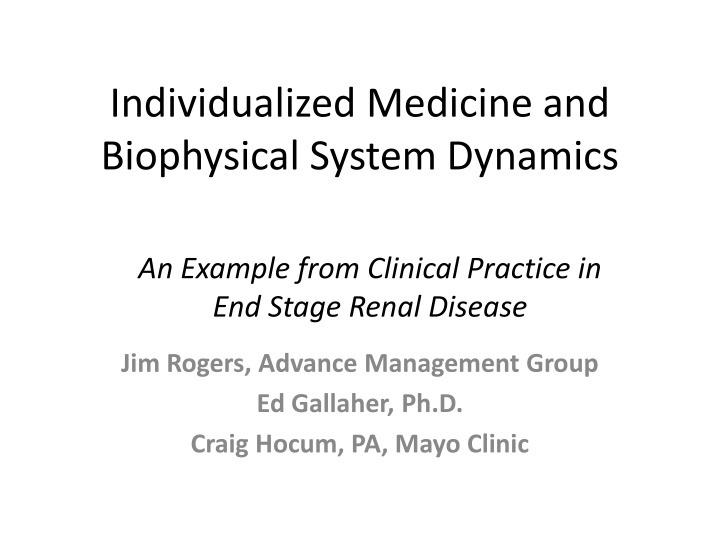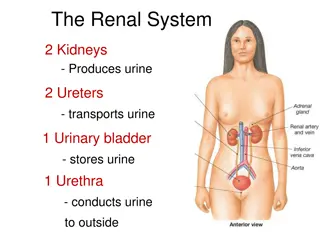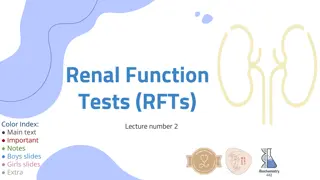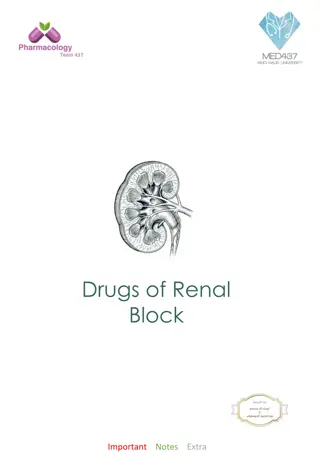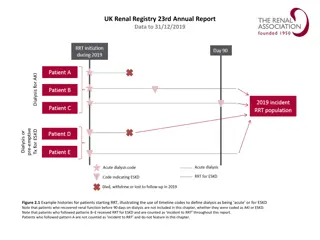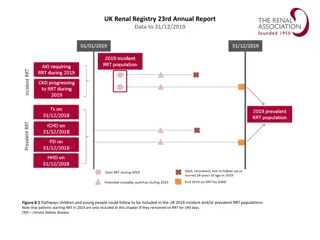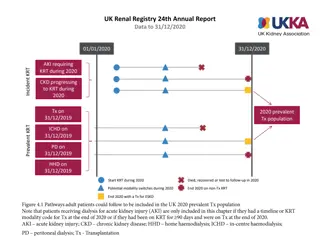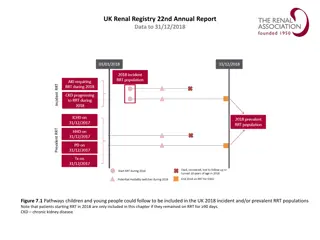Individualized Medicine and Biophysical System Dynamics in End-Stage Renal Disease
This presentation delves into the management of anemia in dialysis patients using system dynamics modeling, particularly at Mayo Clinic. Chronic kidney disease, hemodialysis, anemia, and the significance of erythropoietic stimulating agents are discussed. Anemia poses a key quality of life issue for hemodialysis patients, with symptoms ranging from appetite loss to fainting. While existing treatments like ESA and iron replacement therapy can effectively address anemia symptoms, current protocols may not tackle underlying systemic causes.
Download Presentation

Please find below an Image/Link to download the presentation.
The content on the website is provided AS IS for your information and personal use only. It may not be sold, licensed, or shared on other websites without obtaining consent from the author.If you encounter any issues during the download, it is possible that the publisher has removed the file from their server.
You are allowed to download the files provided on this website for personal or commercial use, subject to the condition that they are used lawfully. All files are the property of their respective owners.
The content on the website is provided AS IS for your information and personal use only. It may not be sold, licensed, or shared on other websites without obtaining consent from the author.
E N D
Presentation Transcript
Individualized Medicine and Biophysical System Dynamics An Example from Clinical Practice in End Stage Renal Disease Jim Rogers, Advance Management Group Ed Gallaher, Ph.D. Craig Hocum, PA, Mayo Clinic
Three Messages Management of Anemia is a Critical Issue for 90% of Dialysis Patients System Dynamics Modeling Helped Redefine and Solve this Problem in Clinical Practice at Mayo Clinic System Dynamics Modeling Provides Tools for Learning in the Emerging World of Individualized Medicine 2
Mayo Clinic Team Members McCarthy, M.D. Hocum, P.A-C Steensma, M.D. Dingli, M.D., PhD. Gudgell, Admin AMG Team Members J. Rogers R. Chrisope E. Gallaher, PhD. M. Diez K. Rogers 3
Chronic Kidney Disease, Hemodialysis, and Anemia -Chronic Kidney Disease (CKD): Any disease that leads to a permanent loss of kidney function. -End Stage Renal Disease (ESRD): a complete/near complete failure of the kidneys to function normally. - Hemodialysis (HD): One of several treatment options for CKD. -90% of HD patients require Erythropoietic Stimulating Agents (ESA) to Prevent and Control the Anemia of CKD. 4
Scratchpad note: 406,000 Dialysis Patients in 2011 x $30,000 per patient = $12.2B /Yr. 5
Terms Hemoglobin The Protein that Enables Transport of Oxygen to the Body and Carbon Dioxide from the Body to the Lungs Erythropoiesis Greek: Erythro ( Red ) + Poiesis ( Making ) Erythropoietic Stimulating Agent (ESA) A Class of Drugs Designed to Replace Erythropoietin Apoptosis Greek: Falling Leaves Refers to Programmed Cell Death 6
Anemia Among Dialysis Patients A Significant Quality of Life Issue for HD Patients Loss of appetite Sleep disturbances Decreased exercise tolerance Inability to concentrate Generalized weakness or malaise, body aches Lightheadedness, dizziness, fainting ESA and Iron Replacement Therapy Can Effectively Treat Anemia. However, Current Protocols do not Address System as Cause Issues. 7
The Purpose of the Model: Find ESA Dosing Regimens That Stabilize a Patient s Hgb in the Center of the Target Range Hgb Too High: Cardiovascular Damage, Thrombosis > 13 Cyclic Period Typically 6-9 Months BTW 10-13 Hgb Target Range < 10 Hgb Too Low: Anemic Months 10
Regulating The Rate of Erythropoiesis Normal Blood O2 Level BN Increased O2 Deficit O2 Carrying Capacity ESA Therapy 15-20 Day Delay BEx Decreased RBC Progenitor Apoptosis Increased Erythropoietin 11
Concept Map of Major Stocks and Flows of Erythropoiesis Bone Marrow Circulation Feedback goes through here! BFU: Blast Forming Unit CFU: Colony Forming Unit 12
Simulation of Hgb Response to Standard Protocol Dose Prescriptions 13
D. 675 Standard Protocol Model Based Protocol 14
D. 722 Standard Protocol Model Based Protocol 15
Mayo Clinic Dialysis Services (MCDS) An Academic, Non-profit Institution Service Arm of Mayo Clinic Department of Nephrology and Hypertension 17 Dialysis Care Facilities 625-650 Prevalent Hemodialysis Patients 15 Physicians; 7 Allied Staff - 2 PAs, 2 NPs, 3 RNs Common Policies & Procedures Shared Dialysis Database
Implementation Timeline Milestone Date Model Version 1 Complete 2Q 2008 Two Pilot Studies Complete 3Q-4Q 2008 Anemia Management Software Application in Place 4Q 2008 Organization-Wide Rollout Complete 2Q 2009 Narrowed Target Hgb Range from 10-13 to 10-12 2Q 2010 Model Version 2 Complete 1Q 2011 17
Sample Interactive BOT Chart Q1 Q2 Q3 Q4 Q5 Q6 Q7 Simulated Historical Hgb Actual Hgb Projected Hgb Actual Iron Dose Iron TFS Recommended ESA Dose Actual ESA Dose 18
Improvements Patient Quality of Life Staff Productivity Cost Reductions First Pass at a Generalized Methodology for Biophysical System Dynamics 19
New Target Target Range Range 21
$700+ 650 $400 Dec-10 22
Observed Reductions in Hospitalizations (Currently Under Study) Measurement Before After % Change Discharges per Patient Year 3.14 2.28 -27% Days Hospitalized per Patient Year 12.2 8.52 -30% 23
Physician Perceptions of the Extensibility of Biophysical Modeling applies to all of medicine. could revolutionize medical care. asks exactly the right questions which are not being asked in medical schools. effectively addresses a fundamental issue at the core of medical care: homeostasis. Places us in grave danger of actually learning something! 24
Future Work Extensions to the Erythropoietic Model Methadone dosing learning environment Other areas: Antibiotics Immunosuppressants Anticoagulants Collaboration with Emerging Departments of Systems Biology Biophysical System Dynamics SIG 25
Three Messages Management of Anemia is a Critical Issue for 90% of Dialysis Patients System Dynamics Modeling Helped Redefine and Solve this Problem in Clinical Practice at Mayo Clinic System Dynamics Modeling Provides Tools for Learning in the Emerging World of Individualized Medicine 26
